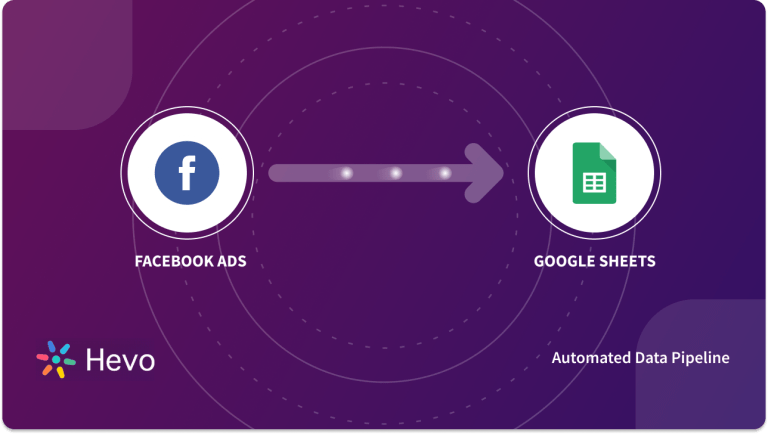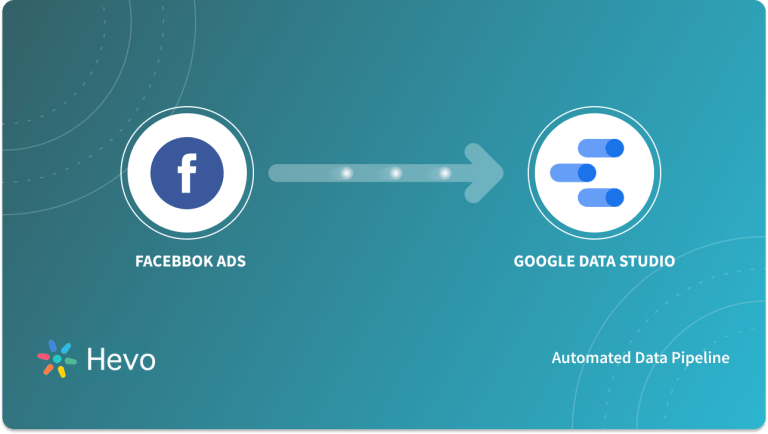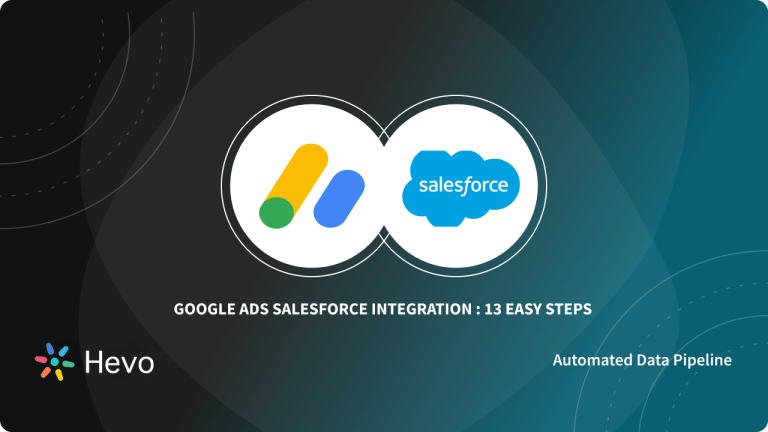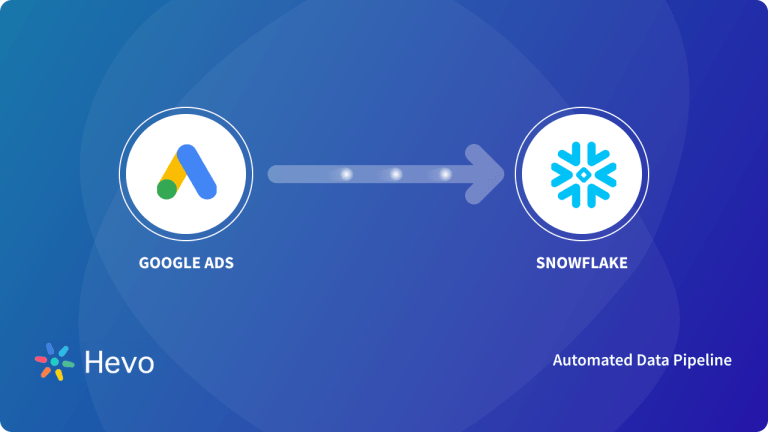 Key Takeaways
Key TakeawaysIntegrating Google Ads with Facebook Ads creates a unified view of marketing performance, enabling better analytics, attribution, and decision-making. Three main methods include:
- Method 1: Hevo Data Platform
Leverage Hevo’s no-code pipelines, pre-built connectors, and automation to seamlessly sync Google Ads and Facebook Ads data into your warehouse without coding or maintenance. - Method 2: Manual CSV Exports
Export campaign data as CSVs from each platform and upload them manually to your database or BI tool. While simple, this method is repetitive, error-prone, and not scalable. - Method 3: APIs
Use the Google Ads API and Facebook Marketing API to build custom pipelines. This approach provides flexibility and control but requires significant technical expertise and ongoing maintenance.
Google Ads and Facebook Ads are the two giants of digital advertising—but they work very differently. Google Ads focuses on intent-driven search behavior, while Facebook Ads highlights audience demographics and interests.
When analyzed separately, these platforms only tell part of the story. By integrating both, you can unlock a complete view of the customer journey, improve attribution, and optimize campaigns with greater accuracy.
In this blog, we’ll walk you through three practical methods—manual exports, APIs, and automated ETL tools—to seamlessly bring Google Ads and Facebook Ads data into your pipelines. The result: less time stitching data, more time generating insights.
Table of Contents
How to Connect Google Ads and Facebook Ads Data (3 Easy Methods)
1. How to Connect Google Ads and Facebook Ads Using Hevo
Hevo provides a no-code, automated solution to bring your Facebook Ads and Google Ads data into a central data warehouse for analysis and reporting. Here’s exactly how to set it up:
Step 1: Prepare prerequisites
Before starting, ensure:
- You have access to active Facebook Ads and Google Ads accounts with the necessary credentials.
- You have the appropriate role in Hevo (Team Administrator, Team Collaborator, or Pipeline Administrator) to create pipelines.
- Disable any browser ad blockers during authentication to avoid issues, especially for Facebook’s OAuth pop-ups.
Step 2: Set up a Facebook Ads pipeline in Hevo
- In Hevo, go to Pipelines and click + CREATE PIPELINE
- Select Facebook Ads as your source
- Authenticate your Facebook account and authorize access
- Select the Facebook Ads accounts and reports you want to replicate
- Define sync settings like historical duration, attribution window, and aggregation preferences
- Test the connection and continue to destination setup
Step 3: Set up a Google Ads pipeline in Hevo
- Again, click + CREATE PIPELINE
- Select Google Ads as your source
- Authenticate your Google Ads account and authorize access
- Choose the ad accounts and reports to ingest (standard or custom)
- Set sync preferences such as historical sync and aggregation window
- Test and continue to destination setup
Step 4: Configure your destination for both pipelines
- Choose your target destination (e.g., Snowflake, BigQuery, Redshift).
- Review and adjust schema mappings if needed.
- Set an ingestion frequency (default: 12 hours, configurable: 30 min–24 hours)
Step 5: Monitor and optimize pipelines
- Hevo auto-syncs historical and incremental data
- Monitor pipeline status and logs
- Hevo refreshes attribution windows automatically and supports time zone alignment if needed.
Step 6: Analyze your unified data
With both pipelines running, your Facebook Ads and Google Ads data will flow into your data warehouse for integrated reporting, cross-channel analysis, and deeper attribution insights.
Customer Testimonial

Advantages
- Hevo uses SSL encryption to secure your data in transit and is a time-tested, mature solution.
- Hevo is future-ready – In the future, if you add another popular software-as-a-service offering to your technology stack, Hevo can easily integrate with the new data streams.
- Hevo automates your data loads to run whenever needed and manages most schema complexities on its own.
- Hevo is fault-tolerant and is built to scale.
- Instead of working on warehousing the data, with Hevo, you work on making your reports better and further stakeholders’ interests in a better way.
Tired of manual exports and scripts?
Hevo lets you automate Google Ads and Facebook Ads data pipelines—no coding required.
Experience a hassle-free automated data replication with Hevo.
Get Started with Hevo for Free2. Using APIs Provided by Facebook and Google
Facebook provides its “Marketing API” and Google provides its “AdWords API” for exporting data. Integrating Google Ads and Facebook Ads using API requires you to follow the step-by-step guide as provided:
Step 1: To retrieve the desired data from Google Ads and Facebook Ads, you can write two separate programs, one for each.
Step 2: Write a program(s) to perform the pre-processing that your destination tool/service supports.
Step 3: Finally, import the data into your destination.
Advantages
- Fine-grained control over what you want and how you want it.
- It’s automated and can be made to run at regular intervals.
- It can support pre-processing.
Disadvantages
- Developer resources are required to achieve this, it’s a more complex option.
- You have to maintain your programs and tune them for any changes in the source or destination.
- In the future, if you add one more channel, like Instagram or Twitter, you will have to write 1 more program.
3. Manual Method via CSV Exports
Now, let’s learn to integrate Google Ads and Facebook Ads using the Manual Method via CSV Export. Here are the steps you can follow to get started:
Step 1: To connect Google Ads and Facebook Ads, login to your Facebook Ads Manager and locate the “Export” button on the top right.
Note: Choose CSV as the desired file format and click “Export”
Step 2: Similarly, go to your Google Account menu and select the “Export” option. Select “CSV files with images in zip archive” OR “CSV files” as the format desired. You can export data from a particular or all your campaigns.
Step 3: Import the above CSVs into your chosen analytics and BI tool or your data warehouse.
Advantages
- It’s the simplest of methods and provides data in a universally accepted format.
- It’s quick, with no extra cost.
Disadvantages
- It’s manual and needs to be repeated again and again, whenever you need the latest data.
- It could be error-prone.
- No pre-processing of data is possible, you haveto manually pre-process the data to suit your destination.
Benefits of Integrating Google Ads and Facebook Ads Data
1. Unified customer journey insights
Combining data from both platforms gives a clear, end-to-end view of how users discover, engage, and convert. This enables more effective full-funnel marketing strategies.
2. Enhanced targeting and retargeting
Leverage behavioral signals from one platform to improve targeting on the other. Build high-quality lookalike audiences and run cross-platform retargeting campaigns that reinforce brand engagement.
3. Holistic performance measurement and optimization
Integrated data enables better attribution modeling, more accurate cost-per-acquisition calculations, and smarter resource allocation across channels.
4. Consistent and coordinated brand messaging
Aligned brand voice and creatives across platforms while delivering tailored sequential messages that guide prospects through their journey.
5. Increased reach and engagement frequency
Reach audiences wherever they are, whether searching on Google or browsing Facebook and Instagram, and boost brand recall through cross-platform exposure.
6. Greater creative flexibility
Use each platform’s unique ad formats to engage users with the right content in the right context, from search ads to videos and carousels.
Understanding Google Ads and Facebook Ads
What is Google Ads ?
Google Ads is an Online Advertising Platform that allows any business to showcase personalized ads in multiple formats, such as Text Ads, Video Ads, and Image Ads. Advertising copy is placed on pages where Google Ads are relevant. Businesses can choose to pay Google on a flexible model (Pay Per Click or Pay for the advertisement shown).
Given Google’s popularity, Google Ads management has become one of the most preferred advertising channels for modern marketers.
What is Facebook Ads ?
Facebook is one of the world’s biggest online social media giant with over 2 billion users around the world, making it the top leading advertisement channel in the world. Studies have shown that Facebook captures for over half of the advertising spend in the US. Facebook ads target users based on multiple factors like activity, demographic information, device information, advertising, and marketing partner-supplied information etc.
Facebook Ads are paid ads like Google Ads, but only appear on Facebook. These ads can be displayed across various places like:
- Video Feeds
- Facebook Marketplace
- Instagram Newsfeed
- Facebook Newsfeed
- Right-Hand Column
- Messenger Inbox
Facebook Ads are more suitable and preferred for reaching out to consumers near the top of the funnel.
In this article, you learned steps to install and leverage the integration of Google Ads and Facebook Ads using three simple methods.
You can try Hevo’s 14-day free trial. You can also look at the unbeatable pricing that will help you choose the right plan for your business needs! install and leverage the integration of Google Ads and Facebook Ads using 3 simple methods.
FAQs
1. Do Google Ads and Facebook Ads work together?
Yes, Google Ads and Facebook Ads can work together to create a complementary advertising strategy. Google Ads focuses on intent-based search ads and display ads, while Facebook Ads targets audiences based on interests, demographics, and behaviors. Using both platforms together can improve brand visibility and conversions by reaching audiences at different stages of the buyer’s journey.
2. What’s the difference between Google Ads and Facebook Ads?
Audience Targeting:
Google Ads: Targets users based on search intent, keywords, and browsing behavior.
Facebook Ads: Focuses on audience targeting using interests, demographics, and user behavior on the platform.
Ad Format:
Google Ads: Search ads, display ads, shopping ads, and YouTube ads.
Facebook Ads: Visual ads such as images, videos, carousels, and stories.
Purpose:
Google Ads: Great for capturing active searchers with high intent.
Facebook Ads: Better for generating awareness and engaging users with targeted messaging.
3. Do Google Ads show up on Facebook?
No, Google Ads do not show up on Facebook. Google Ads appear on Google Search, YouTube, and websites within the Google Display Network, while Facebook Ads are shown only on Facebook, Instagram, Messenger, and partner apps in Meta’s ecosystem.
4. What’s the best way to integrate Google Ads and Facebook Ads data?
You can use manual CSV exports, APIs, or automated no-code tools like Hevo. The choice depends on your technical resources, budget, and scalability needs.
5. How do APIs compare with no-code tools like Hevo?
APIs offer full control and customization but require developer effort and maintenance. No-code tools like Hevo simplify integration, automate syncing, and scale without coding.
6. What are the costs of integrating Google Ads and Facebook Ads data?
Manual exports are free but labor-intensive. API development requires engineering investment. Hevo and similar tools offer tiered pricing based on usage and features.






